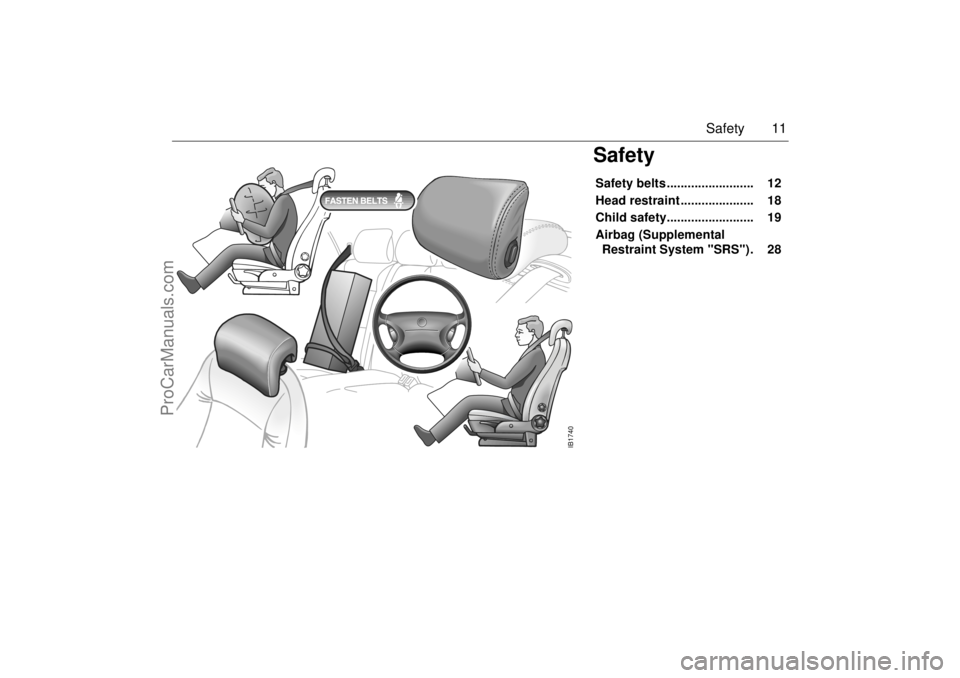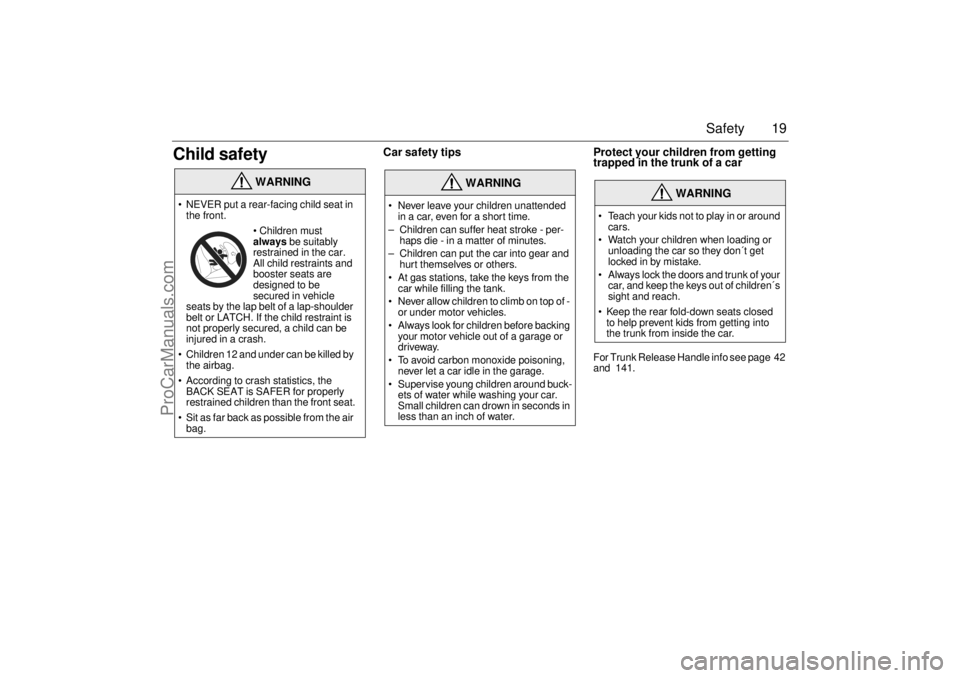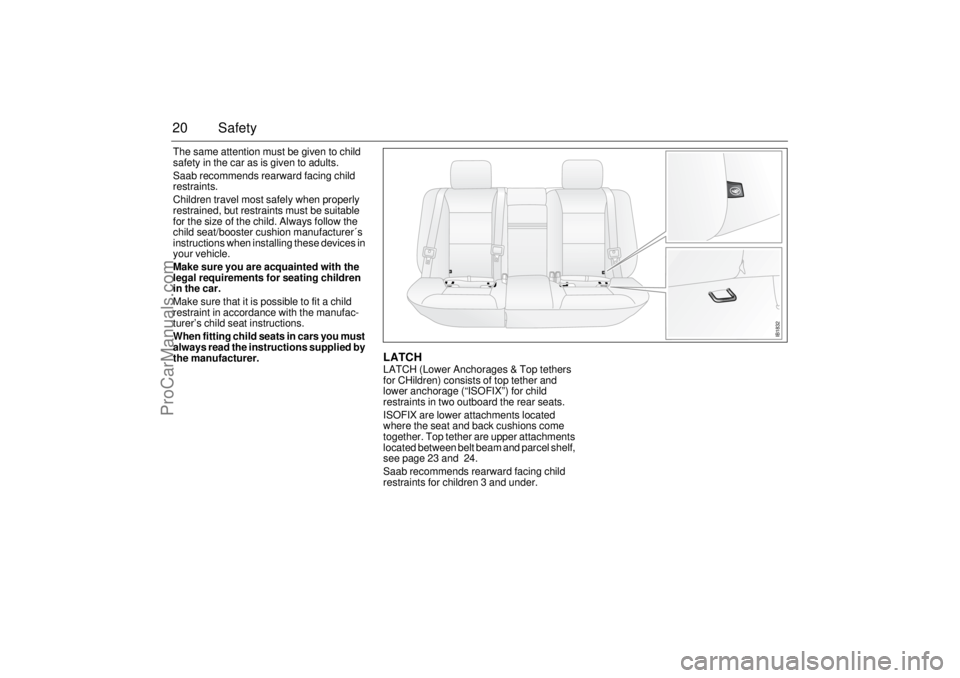child restraint SAAB 9-5 2002 Owners Manual
[x] Cancel search | Manufacturer: SAAB, Model Year: 2002, Model line: 9-5, Model: SAAB 9-5 2002Pages: 272, PDF Size: 16.26 MB
Page 11 of 272

11 Safety
SafetySafety belts ......................... 12
Head restraint ..................... 18
Child safety......................... 19
Airbag (Supplemental
Restraint System "SRS"). 28
IB1740
ProCarManuals.com
Page 19 of 272

19 Safety
Child safety
Car safety tips Protect your children from getting
trapped in the trunk of a car
For Trunk Release Handle info see page 42
and 141.
WARNING
NEVER put a rear-facing child seat in
the front.
Children must
always be suitably
restrained in the car.
All child restraints and
booster seats are
designed to be
secured in vehicle
seats by the lap belt of a lap-shoulder
belt or LATCH. If the child restraint is
not properly secured, a child can be
injured in a crash.
Children 12 and under can be killed by
the airbag.
According to crash statistics, the
BACK SEAT is SAFER for properly
restrained children than the front seat.
Sit as far back as possible from the air
bag.
WARNING
Never leave your children unattended
in a car, even for a short time.
– Children can suffer heat stroke - per-
haps die - in a matter of minutes.
– Children can put the car into gear and
hurt themselves or others.
At gas stations, take the keys from the
car while filling the tank.
Never allow children to climb on top of -
or under motor vehicles.
Always look for children before backing
your motor vehicle out of a garage or
driveway.
To avoid carbon monoxide poisoning,
never let a car idle in the garage.
Supervise young children around buck-
ets of water while washing your car.
Small children can drown in seconds in
less than an inch of water.
WARNING
Teach your kids not to play in or around
cars.
Watch your children when loading or
unloading the car so they don´t get
locked in by mistake.
Always lock the doors and trunk of your
car, and keep the keys out of children´s
sight and reach.
Keep the rear fold-down seats closed
to help prevent kids from getting into
the trunk from inside the car.
ProCarManuals.com
Page 20 of 272

20 SafetyThe same attention must be given to child
safety in the car as is given to adults.
Saab recommends rearward facing child
restraints.
Children travel most safely when properly
restrained, but restraints must be suitable
for the size of the child. Always follow the
child seat/booster cushion manufacturer´s
instructions when installing these devices in
your vehicle.
Make sure you are acquainted with the
legal requirements for seating children
in the car.
Make sure that it is possible to fit a child
restraint in accordance with the manufac-
turer’s child seat instructions.
When fitting child seats in cars you must
always read the instructions supplied by
the manufacturer.
LATCHLATCH (Lower Anchorages & Top tethers
for CHildren) consists of top tether and
lower anchorage (“ISOFIX”) for child
restraints in two outboard the rear seats.
ISOFIX are lower attachments located
where the seat and back cushions come
together. Top tether are upper attachments
located between belt beam and parcel shelf,
see page 23 and 24.
Saab recommends rearward facing child
restraints for children 3 and under.
IB1832
ProCarManuals.com
Page 21 of 272

21 Safety
LATCH installationTo facilitate the proper fitting of new spe-
cially-designed child restraints rigid lower
anchorages (ISOFIX) have been installed to
the vehicle that shall be used with the top
tether anchorages in the two outboard rear
seating positions. There is an additional top
tether anchorage for the center rear seating
position that is to be used together with the
safety belt.
LATCH is a U.S./Canadian government
standard for an uniform method of fitting
child restraints without using the standard
safety belts. Only certain child restraints are
equipped to utilize these rigid lower anchor-
ages behind where the seat cushion and
seat back come together. LATCH child
seats also utilize a top tether strap that is
found on some newer child seats that still
require installation with the standard safety
belts.
There are two bars attached to the car body
for each specially designed LATCH child
restraint. A small label is located on the seat
back just above the outer attachment bars
to facilitate installing the child restraint. The
label contains a circle and a rearward facing
child restraint.1 Open the LATCH (ISOFIX)- lid (1) on
one of the designated outboard rear
seating position by pulling the strap
located on the lid and rotate (2) the lid
upwards. See illustration.
2 Place the child restraint on the seat
cushion.
3 Press the child restraint rearward into
the opening between the lid and the
cushion, lining up the restraint attach-
ment arms with the labels.
4 Follow the child restraint instructions to
confirm that both restraint arms are
properly attached to the bars.
5 Attach the top tether strap to the in-car
anchorage and tighten according to the
restraint instructions, see page 23 and
24.
6 Pull the child restraint to make a second
check that restraint is securely attached
at both the lower anchorage bars and
the top tether strap.
IB1938
12
Open the LATCH-lid.
ProCarManuals.com
Page 22 of 272

22 SafetyFor the top tether, only use the strap sup-
plied with the child restraint.
Always follow the installation instructions
supplied with the child restraint.
The availability of LATCH child restraints
may be limited.
When fitting child seats in cars you must
always read the instructions supplied by
the car seat manufacturer.
IB1684
Rigid 2-point lower attachment with top
tether
IB1685
Semi-rigid 2-point lower attachment with
top tether
ProCarManuals.com
Page 23 of 272

23 Safety
Child tether anchorages for forward
facing child car seatsChild restraints with a tether strap must be
anchored according to Canadian and USA
laws.
If you have any questions regarding child
tether anchorages please contact your
Saab dealer.9-5 Sedan:
1 Open the cover that is right behind the
child restraint. Make sure it locks.
2 Place the child restraint in the rear seat.
3 Secure the lower part of the child
restraint by means of the lower anchor-
ages (ISOFIX) or the safety belts as
described in the child restraint mounting
instruction.
4 Route the tether under the headrest.
5 Attach the tether to the anchorage.
6 Tighten the tether so that the back of the
child restraint is pressed hard against
the backrest.
7 Pull the child restraints to make a
second check that the restraints are
securely attached at both the lower
anchorages bars and the top tether
strap.
WARNING
Child tether anchorages are designed to
withstand only those loads imposed by
correctly fitted child restraints.
Under no circumstances are they to be
used for adult safety belts.
IB1698
Child tether anchorages in parcel shelf,
Saab 9-5 Sedan
ProCarManuals.com
Page 24 of 272

24 Safety9-5 Wagon:
1 Fold the backrest of the rear seat for-
ward, see page 132.
2 Fold the anchor that is right behind the
child restraint to its upright position.
3 Place the child restraint in the rear seat.
4 Raise the head restraint to its upper
position and then route the tether under
the head restraint.
5 Attach the tether to the anchor.
6 Raise the backrest of the rear seat.
Make sure it locks properly.
7 Secure the lower part of the child
restraint by means of the safety belt or
lower anchorages (ISOFIX) as
described in the child restraint mounting
instruction on the previous page.8 Tighten the tether so that the back of the
child restraint is pressed hard against
the backrest.
9 Pull the child restraints to make a
second check that the restraints are
securely attached at both the lower
anchorages bars and the top tether
strap.
It is not possible to route the tether through
the cargo net (accessory), if one is fitted.
Instead we recommend a cargo guard
(accessory).
WARNING
Make sure the child-restraint anchorages
are folded all the way up or down other-
wise it can obstruct locking the rear seat
backrest.
IB1352
Child tether anchorages, Saab 9-5 Wagon
ProCarManuals.com
Page 26 of 272

26 SafetyInstallation of child restraint using the
standard safety belt
Child restraint that are approved for rear-
ward facing installation in the rear seat can
be positioned in any of the three rear places.
If you intend to install another make of child
restraint make sure that it is possible to fit it
in accordance with the manufacturer’s
instructions.
Saab recommends rearward facing child
restraints up to 3 years.
WARNING
Failure to follow all the manufacturer’s
instructions on the use of this child
restraint system can cause your child to
strike the vehicle´s interior during a
sudden stop or crash.
WARNING
A special accessory is available for lock-
ing the center armrest so that a child seat
can be installed in the middle seat. See
your Saab dealer for details.
When a rear-facing child seat is fitted in
the center position of the rear seat in the
Saab 9-5 Sedan the center armrest must
be secured in place with this strap. If this
is not done, the center armrest could
swing down in the event of a frontal crash
and cause injury to the child.
IB1204
Fitting the locking strap on the center arm-
rest, Saab 9-5 Sedan (not needed on
Wagon).
The locking strap is standard equipment
in certain markets.
ProCarManuals.com
Page 28 of 272

28 Safety
WARNING
Use only the vehicle’s lap and shoul-
der belt system when restraining the
child in the booster seat.
The seat must not be modified or
changed in any way.
Never leave a child unattended.
The car’s regular head restraint must
always be turned 180° back to its orig-
inal position after the integrated
booster seat is folded away.
Check to ensure that the belt is not
twisted or rubbing against any sharp
edges.
Label in integrated booster seat
ProCarManuals.com
Page 29 of 272

29 Safety
Airbag (Supplemental
Restraint System
"SRS") The supplementary restraint system (SRS)
comprises an airbag in the steering wheel,
a front passenger airbag and side airbags in
the front seats.
The system supplements the protection
provided by the safety belts to further
enhance the safety of the occupants.
If a fault is detected in the SRS, the
AIR BAG warning light on the main instru-
ment panel will come on (see pages 52 and
34). When the system is triggered by impact of a
frontal crash, the airbags in the steering
wheel and passenger side of the dash board
are inflated, after which they deflate through
vents in the back of the bags.
The front airbags are inflated in two stages.
The first stage process is a less severe,
softer inflation of the airbag. This stage is
used in lower force crashes, or if the seat is
positioned close to the steering wheel or
dashboard. The second stage process is a
more forceful and quicker inflation of the air-
bag. This stage is used in more severe
crashes and/or when the seat adjustment is
back a significant distance from the steering
wheel or dashboard.
The entire process takes less than
0.1 second – literally, faster than the blink-
ing of an eye.
These airbags are triggered only by moder-
ate to severe frontal or near-frontal crashes.
They will not be activated by minor front-end
impacts, rear-end or side impacts, or by the
car rolling over.
WARNING
To reduce risk of injury:
Always wear your safety belt.
Always adjust your seat so that you
are as far back as possible but still
able to reach the steering wheel and
controls comfortably.
Children 12 and under or shorter than
140 cm (55 inches) should always
travel in the rear as the vehicle is
equipped with an airbag on the pas-
senger side.
WARNING
Even if the car is equipped with SRS
(airbag), safety belts must still always
be worn by all occupants.
Note that because an airbag inflates
and deflates extremely rapidly, it will
not provide protection against a
second impact occurring in the same
incident. Always use your safety belt.
Always sit with the whole of your back
in contact with the backrest of the seat,
and with your seat as far back as is
practical. This is to reduce the risk of
injury from contact with the backrest of
the seat when the airbag inflates and
also because the airbag needs space
in which to inflate.
Never attach anything to the steering
wheel or passenger side of the instru-
ment panel, as this could result in
injury if the airbag should inflate. The
same applies to anything you might
have in your mouth, such as a pipe, for
instance.
Some components of the airbag will
be warm for a short time. In some cir-
cumstances the airbag can cause
minor burns or abrasions to the body
when the airbag inflates/deflates.
ProCarManuals.com